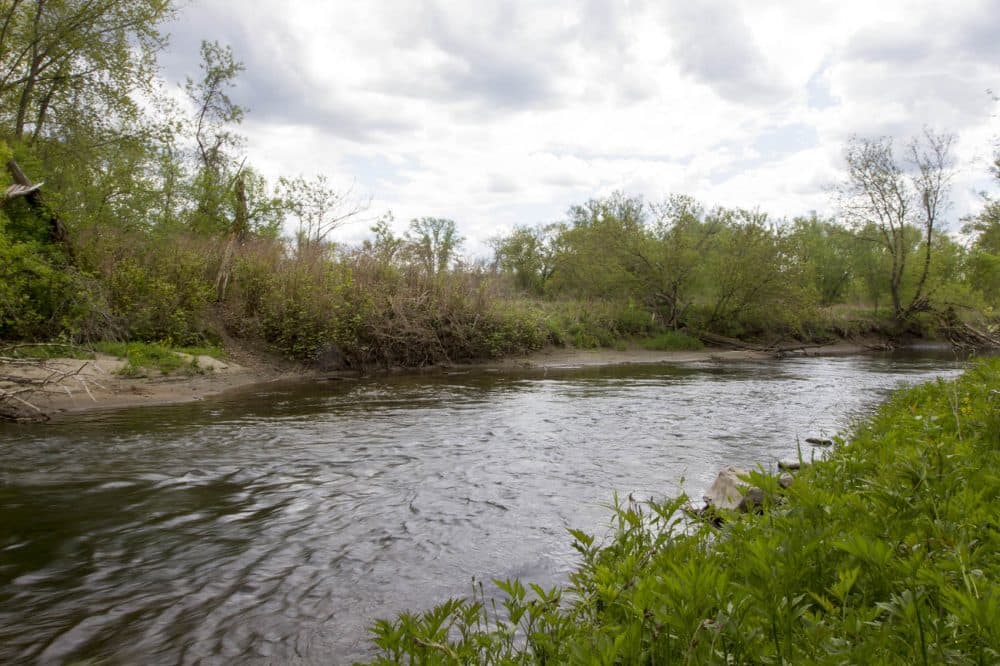Advertisement
In Housatonic River Deal with GE, Towns Agree To Toxic Waste Dump In The Berkshires

After more than a year and a half of mediation, the U.S. EPA New England office, General Electric and cities and towns along the Housatonic River have agreed to dispose some of the toxic PCB sediment at a site on the Lee-Lenox line, about 1,000 feet from the river. But not all participants in the mediated settlement agree with the decision.
An event marking the announcement was scheduled for Monday afternoon in Lenox, right next to the Housatonic River and Woods Pond – which has high volumes of sediment contaminated with PCBs.
GE polluted the river with PCBs for decades from its former transformer plant in Pittsfield. The EPA now says PCBs can cause a “multitude of serious adverse health effects” in the reproductive, endocrine, immune and nervous systems. The agency classifies PCBs as a probable human carcinogen.
The agreement calls for disposing the “most contaminated waste” dug up from the river, its banks and floodplains out of state. GE will choose from about a dozen regulated facilities, all of which are outside Massachusetts.
Material with “lower levels of waste” would be dumped in a disposal facility to be built by GE on the site of a former gravel pit on the Lee-Lenox line.
This marks a reversal for the EPA and the towns. They had previously argued that all PCB-laden waste should be shipped out of state. GE, which is on the hook for the cleanup costs, objected.
In 2016, the EPA wrote in its response to comments on its cleanup plan that the proposed site on the Lee-Lenox line does not meet Toxic Substances Control Act requirements for soil or hydrological characteristics, meaning the soil is too permeable and the location is too close to the water table.
But under the agreement announced Monday, that site has been chosen to store “lower levels of waste.”
According to the EPA, the ”average concentrations of PCBs” in the proposed landfill in the Berkshires will be 20-25 parts per million, “well below the 50 ppm federal criterion for commercial PCB landfills.”
The EPA said GE will build a “state-of-the-art” facility with a double liner on the bottom, a leachate collection system and groundwater monitoring.
Advertisement
As part of the settlement, GE agrees to pay Lenox, Lee, Great Barrington, Stockbridge and Sheffield a total of $55 million dollars. Pittsfield will get $8 million.
Those municipalities are part of the group that reached the agreement. It also includes the state of Connecticut, Massachusetts Audubon Society, C. Jeffrey Cook—a Pittsfield resident whose property is next to the river, and the Berkshire Environmental Action Team. The state of Massachusetts did not participate in the mediation.
Another environmental group, The Housatonic River Initiative, is against the agreement.
In an interview before the settlement was made public, the group’s Tim Gray said toxic dumps are dangerous for people.
“We are going to be very upset if there's a deal on the table to let them build a dump here in Lenox Dale-Lee,” Gray said.
The settlement includes some property transfers. GE will donate the woodland above Rising Pond to Great Barrington, and is giving a building and a parking lot to the city of Pittsfield.
The settlement modifies the cleanup plan proposed by the EPA in October 2016. Five parties filed appeals with the EPA’s Environmental Appeals Board, including General Electric and environmental groups. In 2018, the appeals board approved most of the cleanup plan, but did not issue a decision on EPA’s proposal to send the waste to a regulated facility outside of Massachusetts.
That issue became the main focus of the mediation.
Another issue was how soon the cleanup will start. Under the agreement, GE said it will start the investigation and design work for the cleanup immediately, including sampling contaminated areas.
An additional unresolved question before the mediation was GE’s long-term responsibility for PCB waste if there are future projects on the river, such as work on dams or docks. This was of particular concern to the state of Connecticut. As part of the new agreement, GE will be responsible for removing PCBs if there is future work in the river downstream of the former plant.
The agreement also includes the removal of two mill dams on the river, the Columbia Mill Dam and Eagle Mill Dam, both in Lee.
The EPA plans to hold three public meetings on the settlement agreement in Lee, Great Barrington and Pittsfield in February and March. In addition, the agency will open a 45-day public comment period. The EPA said it will consider public comments and, based on them, possibly revise the plan — before the end of this year.
This is the third phase of a cleanup plan. The original cleanup settlement, reached in October 1999, focused on the first two miles of the river downstream of the GE plant. It also included land-based cleanup of PCBs outside of the Housatonic River, and an analysis of this third phase — removing PCBs from about 30 miles of the river from Pittsfield to Great Barrington, known as “Rest of River.”
Under the 1999 deal, Pittsfield agreed to have sediment containing PCBs buried in two disposal sites in the city, one of which is next to Allendale Elementary School. GE gave Pittsfield $10 million over ten years and another $15.3 million to the Pittsfield Economic Development Authority. GE also transferred about 50 acres of its former plant site to the city.
The “Rest of River” cleanup has long been delayed. In a press release dated October 7, 1999,the EPA said it would decide on final cleanup plan by 2002. The settlement announced Monday is another step towards a final plan.
This story first published on New England Public Radio.